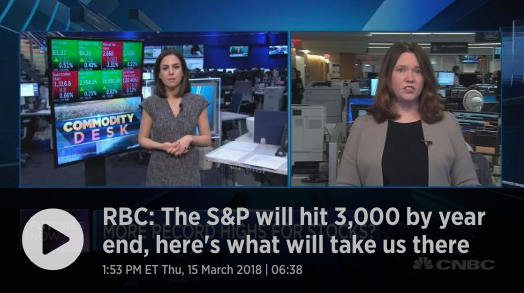Yesterday proved to be a most interesting trading day with the Dow falling as much as 490+ points. The most interesting point of the major averages, which fell in unison, is that they did so in such a steady and methodical fashion. Panic and great volume was absent the decline that happened in a more zombie-like fashion. The Arms Index, a volume-weighted breadth measure that usually rises above 1.000 when stock market falls, as sellers of declining stocks tend to be more aggressive than buyers of advancing stocks, rose to just 1.508 for the NYSE. Some market technicians feel a rise above 2.000 suggests panic-like selling. But that is not what was expressed in the markets yesterday, panic. We’ve seen market panic before and most recently in the month of February where the Dow fell more than 1,000 points on two occasions. Yesterday was anything but panic and as such we’ll have to see if that actually means or foreshadows future market breadth.
In yesterday’s trade, the Dow fell 335.60 points, or 1.4%, to 24,610.91. The S&P 500 index dropped 39.09 points, or 1.4%, to 2,712.92, weighed down by a 2.1% decline in the technology sector, the worst performer among the broad-market benchmark’s 11 sectors. The Nasdaq Composite Index lost 137.74 points, or 1.8%, to 7,344.24.
Whether it was President Trump’s “tweet storm” over the weekend that rebuked the Mueller investigation or the looming tariff uncertainty and implementation of trade tariffs that caused yesterday’s sell-off remains speculative at best. To accompany such uncertainty was Facebook’s latest tribulations. Following in the footsteps of the President’s tweets this weekend was a firestorm related to how Facebook Inc. manages third-party access to its users’ information and after the social network said a firm in the U.K. improperly kept data for years despite saying it had destroyed those records.
This relationship found U.S. and British lawmakers scrutinizing the social media giant over the weekend for not providing more information about how the data firm, Cambridge Analytics, came to access information about potentially tens of millions of the social network’s members without their explicit permission. According to the New York Times, Senator Amy Klobuchar of Minnesota, a Democratic member of the Senate Judiciary Committee, went so far as to press for Mark Zuckerberg to appear before the panel to explain what the social network knew about the misuse of its data “to target political advertising and manipulate voters.”
“This is a big deal, when you have that amount of data. And the privacy violations there are significant,” Sen. Jeff Flake, R., Ariz., a member of the Senate Judiciary Committee, said in an appearance on CNN. “So, the question is, who knew it? When did they know it? How long did this go on? And what happens to that data now?”
Another residual effect with regards to the turmoil at Facebook centered on the company’s Chief Information Security Officer Alex Stamos is reportedly leaving after disagreements over how the social media network should handle the spread of disinformation. The news was first reported by The New York Times, and later independently reported by Reuters and the Wall Street Journal.
Beyond Facebook and what may have proven a catalyst for yesterday’s market sell-off, uncertainty is seemingly the underlying theme of the markets break down over the last 30 days or so. We can point to many reasons for the uncertainty that stem from the Presidential proclamation on trade tariffs down to fears of inflation and whether or not the economy is strong enough to withstand 4 rate hikes in 2018. Regardless of the weighting of each variable, however, as a collection the uncertainty looms large and has found most market rallies sold in quick fashion. As it stands, markets remain in the correction phase. Finom Group believes until this trend of “selling the rips” subsides, investors should trade accordingly and in kind with the broader market trend and sentiment.
The Federal Open Market Committee begins a two-day meeting today and will release new economic and interest rate forecasts Wednesday. The Fed is expected to raise rates by .25 basis points, but the future course of rate hikes is uncertain. Will it be 3 or 4 rate hikes for 2018? That is the question on investors’ minds.
“We don’t see any reason for an abatement of this market pressure coming on before the Fed. After the Fed, we’ll have to see what their message is,” said Julian Emanuel, head of equities and derivatives strategy at BTIG. “The [White House] personnel turnover at the margin increases uncertainty, and markets dislike uncertainty. There are so many uncertainties right now —politically, economically, monetarily.”
Public and private scrutiny over the political issues coming out of the White House are abound and finding many analysts and economists to revise their 2018 outlook. But on the whole, most believe that the underlying economic conditions will produce strong earnings growth for the year. As such, while near term uncertainty is weighing on markets, by year end most analysts believe markets will be higher than where they reside today. Lori Calvasina, head of equity strategy at RBC Capital Markets, told CNBC’s “Futures Now” last week the following:
“Washington has turned into more of a headwind than a tailwind recently,” she said, suggesting the constant personnel changeovers and turmoils were beginning to make investors nervous.
“It’s enough to slow down the ascent a little bit, to cause us to stumble here and there, but not enough to derail the bull case at this point.”

“Any time you see political uncertainty rise you do tend to see an uptick in volatility,” said Calvasina. “Like anything that comes out on the policy front, there’s an initial sort of shock upfront and some worries are factored in, but ultimately people settle down and say the devil is in the details.”
And then there is Tony Dwyer, chief market strategist at Canaccord Genuity. Dwyer recently called the market pullback that occurred in February. He also told CNBC yesterday that the current pullback in the market is a good buying opportunity. “The entire market is fine,” Dwyer said on “Fast Money.
“You get one of these selloffs and it feels like we’re going to break down and tank,” he said. “During those periods, I want to remind everyone, we’re going to have 20 percent earnings growth this year. That’s one hell of a multiple compression. “You want to buy dips. Markets are not based on time. They’re based on Fed policy.”
With all the uncertainty and all the “buy the dip” proposals from analysts, the markets remain in a state of flux that is no better represented than in the volatility complex. The VIX soared yesterday by nearly 30% at one point. The VIX ripped above 21 intraday before finishing just above 19. And with that, the Dow has turned negative for the year, off 0.4%, while the S&P is up 1.5% and the Nasdaq has advanced 6.4%.




